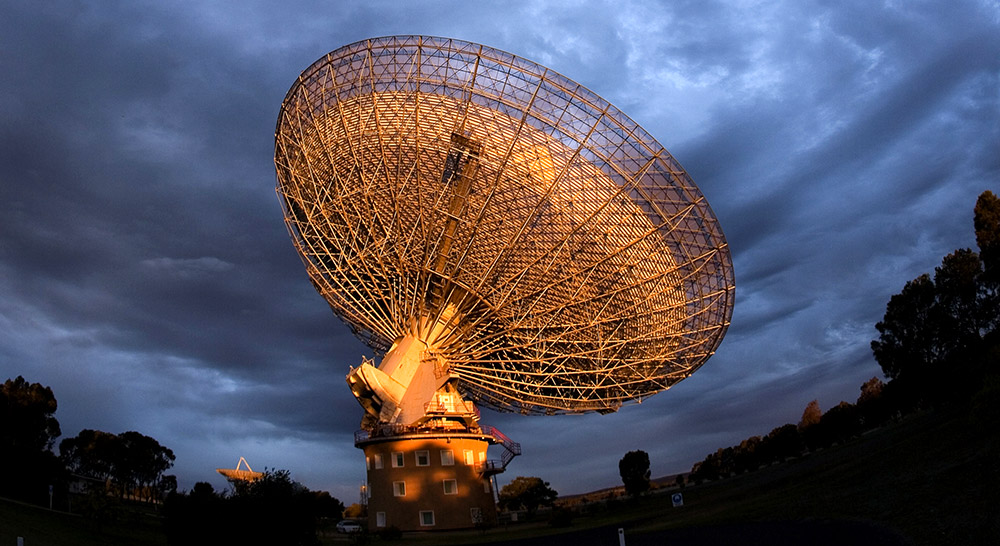Not extraterrestrial: In 2020, astronomers have picked up a possible technical signature from our neighboring star Proxima Centauri – a possible radio signal from extraterrestrial technology. But subsequent analyzes now reveal: the radio signal, christened BLC1, is of terrestrial origin and originated from distortion of terrestrial radio signals. BLC1 is still useful because it has made it possible to improve checklists and test algorithms, the team explains in the specialist journal Nature Astronomy.
As part of the SETI and Breakthrough Listen projects, astronauts have been listening in space for a long time in order to pick up technical fingerprints: radio signals that could come from an extraterrestrial civilization. So far, however, none of the few candidates for such a signal has been verified – neither the famous WOW signal from 1977, nor one discovered by Russian astronomers in 2015.

BLC1 – signal from Proxima Centauri?
But in the summer of 2020, there was another alarm among “alien” researchers: the Parks Radio Telescope in Australia picked up a signal that appears to come from the direction of our neighboring star Proxima Centauri. The frequency is 982.002MHz, which is unusual for jammers, the very narrow frequency band of only about 1 Hz and the frequency deviation in the typical signal curve of moving sources correspond to the characteristics of the technical signature.
“The event is in a frequency band from which local radio interference sources are not known, and has many properties that could fit a station in another star system,” explain signal discoverer Shane Smith of the University of California, Berkeley and colleagues. In addition, this signal was only captured when the Parkes telescope was pointed directly at Proxima Centauri, and not during control measurements in other directions.
But was the baptized BLC1 signal really of extraterrestrial origin? To illustrate, Smith, colleague Sophia Sheikh and other astronomers from the Breakthrough List initiative for the first time repeated measurements with the Parkes telescope and a second radio telescope in Australia in 2020 and 2021. However, in both cases, after filtering out all sources of interference, no signals could be detected Radio with a frequency deflection similar to that of the BLC1. The signal no longer occurs.
Signal “clones” in off-source data
The astronomers then examined raw data collected by the Parks telescope in 2019. In doing so, they encountered four similar signals, which were previously immersed in background noise due to their low power, and which also occurred when the telescope was pointed toward Proxima Centauri. But more importantly, another 36 very similar signals also occurred while the telescope was positioned further from the source – when it was targeting other parts of the sky for control purposes.
“Our turboSETI software initially marked these signals as hits early in the test, and then rejected them as interfering signals because they occurred at a locus far from the source,” the researchers explained. Further research revealed that there are 27 other radio signals in the out-of-source feedback that are very similar to BLC1, but their frequency deviation is reversed.
Distorted echoes of electric oscillations
The deciding factor, however, is that all of these “similarities” to the BLC1 mystery signal occurred when the Parks Radio Telescope was moved away from Proxima Centauri and instead looked in other directions. “In addition, these signals appear in the data at regular intervals and these periods appear to correspond to the frequency multiplier used by oscillators in various common electronic devices,” Sheikh explains.
From the results of their analyzes, the astronomers concluded that the possible “alien” signal BLC1 is not of cosmic origin, but of terrestrial origin. Most likely, its unusual frequency and signal geometry resulted from a multimodal distortion of the radio emissions of a 2 MHz clock oscillator. Interaction with some other interfering signals resulted in BLC1 signaling and its counterparts.
“Taken together, this suggests that the signal is coming from human technology, even if we can’t pinpoint the exact source,” Sheikh says.
Optimizing checklists and testing algorithms
Although this may seem disappointing at first to the search for signs of extraterrestrial life—the search for extraterrestrial intelligence—the signal and the lessons learned from it are an important step forward, the team stresses. They explain, “Although we classify BLC1 as an interfering signal, the lessons learned from its analysis will benefit research over the next few years.” Because on the basis of these results, the checklist and test algorithms for such observations can now be completed and determined with greater accuracy.
“While we haven’t found a real technical signature yet, we are very confident that we have the tools to detect and verify these signals when they are present,” said Pete Worden, CEO of Hacking Initiatives. (Natural Astronomy, 2021; doi: 10.1038/s41550-021-01479-w; doi: 10.1038/s41550-021-01508-8)
Quelle: Breakthrough Initiatives, Natural Astronomy

“Unapologetic pop culture trailblazer. Freelance troublemaker. Food guru. Alcohol fanatic. Gamer. Explorer. Thinker.”




